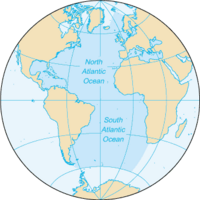
Photo from wikipedia
ABSTRACT Liritzis, I.; Preka-Papadema, P.; Antonopoulos, P.; Kalachanis, K., and Tzanis, C.G., 2018. Does astronomical and geographical information of Plutarch's De Facie describe a trip beyond the North Atlantic Ocean?… Click to show full abstract
ABSTRACT Liritzis, I.; Preka-Papadema, P.; Antonopoulos, P.; Kalachanis, K., and Tzanis, C.G., 2018. Does astronomical and geographical information of Plutarch's De Facie describe a trip beyond the North Atlantic Ocean? In Plutarch's book On the Apparent Face in the Orb of the Moon, the interlocutors develop a dialogue about a trip to the “great continent” beyond the North Atlantic Ocean. By applying modern scientific data, the present reappraisal of the astronomical and geographical elements within this dialogue has produced a novel interpretation of the date and place of the meeting and a journey to the northern Atlantic Ocean. A described solar eclipse is dated to AD 75, making use of the National Aeronautics and Space Administration (NASA)/Espenak/Meeus list, as well as historical information. The described peculiar, recurrent trips take place every 30 years (when the planet Saturn reaches the Taurus constellation) from the Mediterranean Sea to the Cronian Open Sea, which is identified with northern Atlantic Ocean coasts. It has been suggested that the last mission had returned homeland in April AD 56. The information provided concerns, distances between coastal sites and islands, duration of sea paths in days, and the reported setting and size between the destination place and its gulf with regards to Azov (in Crimea) and the Caspian Sea. Implications of sea currents and the coastal geomorphology of those lands are given. Following strictly the Gulf Stream current, as well as other known sea currents in the northern Atlantic Ocean, and introducing estimated speed for the ship, the geographical location of destination of the Greek settlers is proposedly identified with St. Lawrence Gulf and Newfoundland island. Other unnamed islands mentioned in this dialogue are identified with Norway's islands, Azores, Iceland, Greenland, and Baffin islands. It has been shown that the journey is made with good knowledge of sea currents but by using bright stars and stellar configurations as astronomical nightscape markers that determine the exact orientation of the sailing toward the Iberian Peninsula and back to the eastern Mediterranean, making the current working hypothesis a plausible event.
Journal Title: Journal of Coastal Research
Year Published: 2017
Link to full text (if available)
Share on Social Media: Sign Up to like & get
recommendations!